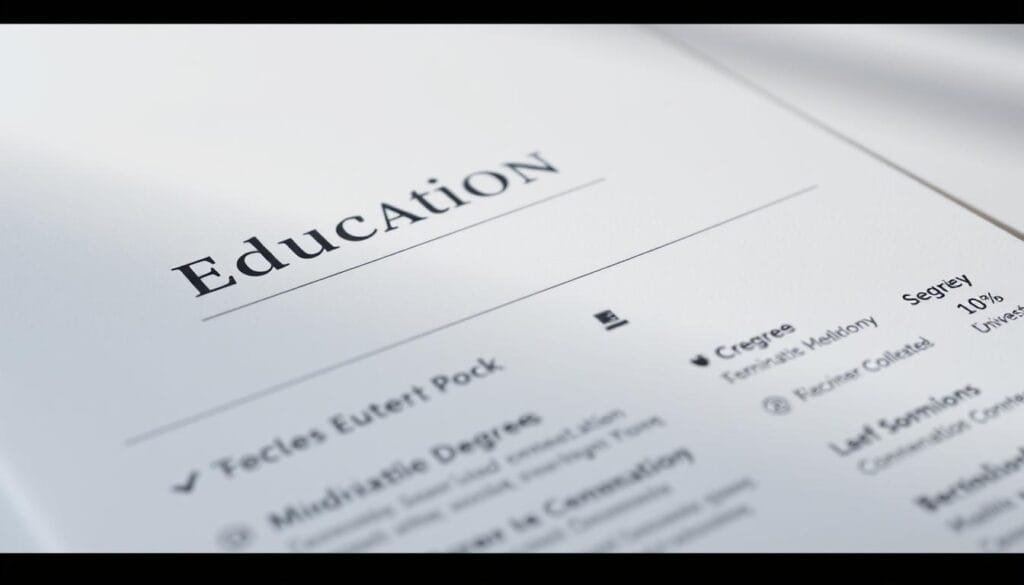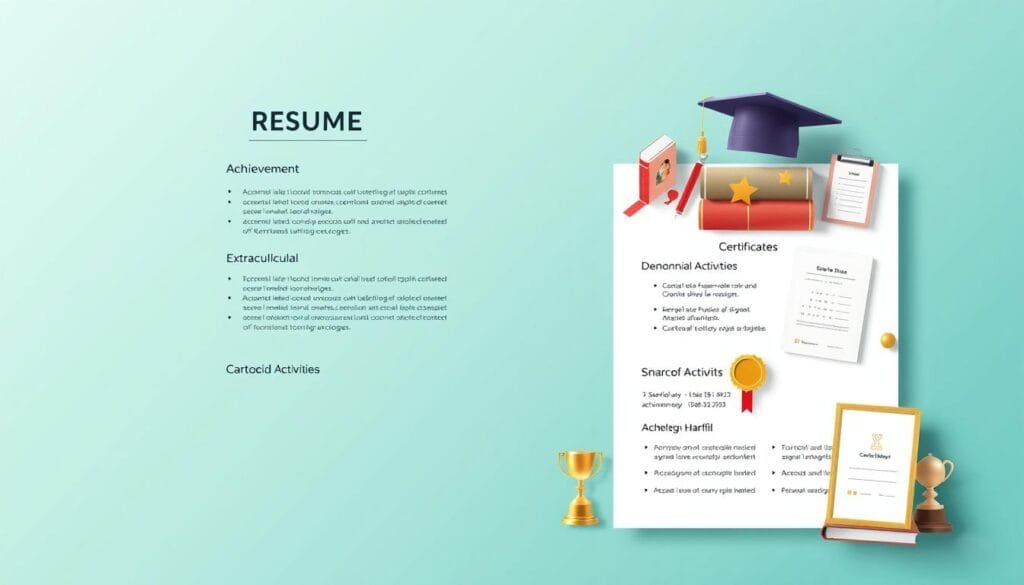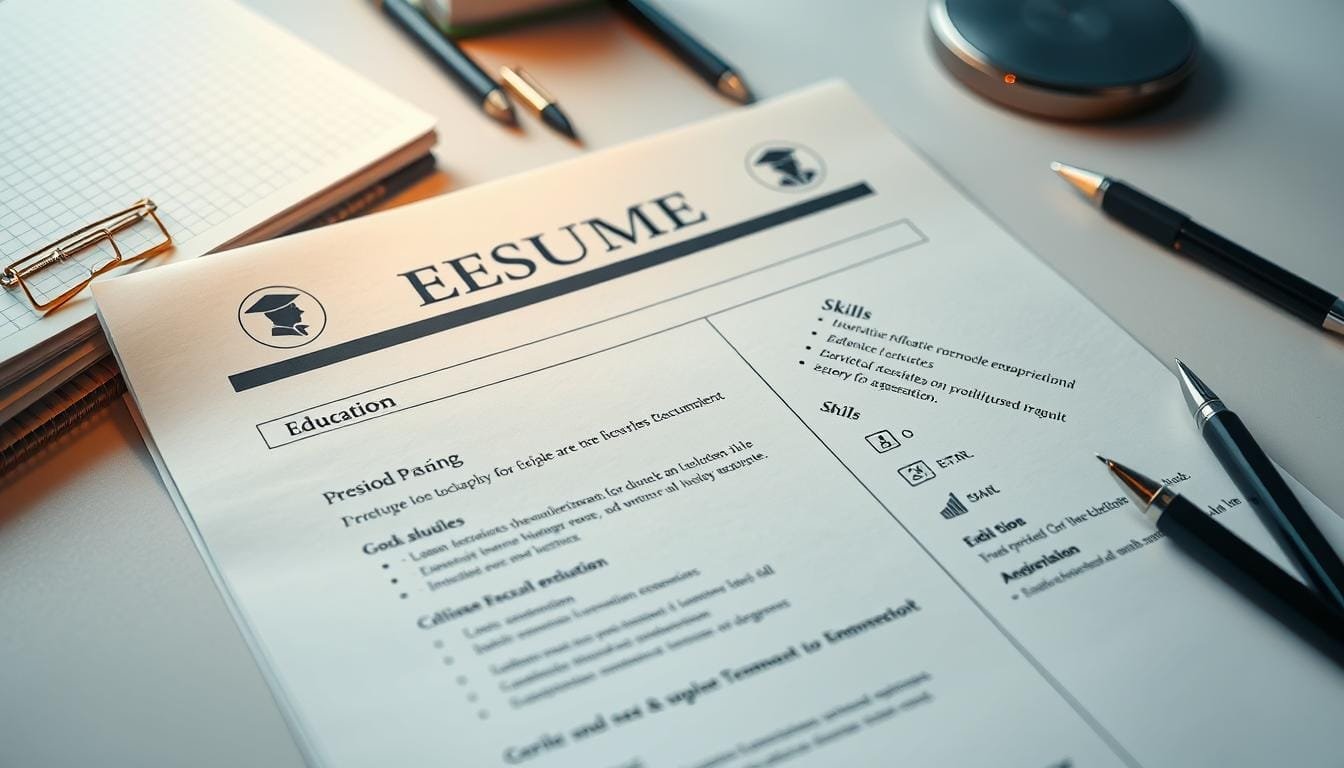In today’s tough job market, your resume opens the door. A smartly written education section can make you stand out. It shows off your school wins and why you’re great for the job. This could be as a fresh grad or someone aiming for a big career switch. You need a smart plan to list your education. This includes your degrees, certs, and big wins, while thinking about your career stage and what the job wants1. Adding important stuff like what degree you got, where from, its location, and when you went there can really make your resume better1.
Key Takeaways
- Strategically organize your resume education section to align with career level and job requirements1.
- Emphasize academic achievements when they provide a competitive edge or when work experience is limited1.
- Include essential education information and consider optional details like honors and GPA only if advantageous1.
- For seasoned professionals, prioritize work experience over education unless a recent degree enhances the job application1.
- Utilize templates to ensure your resume is not only informative but also visually compelling and well-organized1.
Understanding the Importance of Your Resume’s Education Section
The education part of your resume is more than just meeting degree needs. It shows your ability to fit into structure and highlights your school achievements. This makes it key for showing you’re right for the job. Making sure this section is done right improves your application.
Why Education Matters to Employers
In fields that need special training, the resume education importance is high because it proves you have the right skills. If you went to a well-known school or got top honors, it can make up for less job experience. This needs to be done in a clean way as a resume guide suggests. Employers look for this to gauge if you’re up for the job’s challenges1.
The Role of Education in Your Overall Resume
Education’s importance on a resume changes as you gain more work experience. For new grads or those switching careers, a detailed education section is critical. It should show awards, a GPA above 3.5, and activities that prove useful skills like leadership2. If you’re well into your career, focus more on job experience unless your degree directly relates to the job1. Always list education from newest to oldest to keep your resume tidy1.
Rightly showing your education based on the job you want is vital. It strengthens your resume, showing you’re fit for the role and future growth.
Deciding the Placement of Education on Your Resume
The placement of the education section on your resume is very important. It grabs the attention of employers. For those just out of school, showcasing your school achievements is key.
If you’re just starting your career or don’t have much job experience, put your school details first. This shows off your academic success and any useful courses you’ve taken3.
But if you’ve been working for a while, list your job history first. For experienced folks, work achievements take the lead. You still include your education, but it’s not the main focus, unless the job asks for it3.
| Resume Type | Education Placement | Justification |
|---|---|---|
| Recent Graduate | Top | Highlights academic strengths and relevant projects |
| Professional Experience | After Work Experience | Emphasizes professional achievements and expertise |
Highlight your school wins, like a high GPA or awards, whether you’re new to the job world or not. These achievements can show employers what you’re capable of. They’re very useful for those with fewer job experiences3.
Think about adding online courses or degrees, as online learning gets more common. Only add them if they match the job you want and your career goals4.
Your resume’s layout should complement your career goals well. Mix your school and work info smartly to stand out as a top candidate. Always aim to spotlight your most relevant skills and achievements34..
How to List Degrees and Certifications
When you’re putting together your resume, it’s very important to clearly show your degrees and certifications. Doing this well can really help you stand out by showing what you have achieved.
Formatting Degrees: Chronology and Detail
Your resume should list education in a clear and direct way. Put your degrees in reverse order, starting with the most recent one  . Include the degree type, your major, the school’s name, and the year you graduated3. If your GPA is above 3.5, mention it to show you did well53. But, if you got your degree over five years ago, you might leave off the graduation date. This helps avoid any bias because of age5.
. Include the degree type, your major, the school’s name, and the year you graduated3. If your GPA is above 3.5, mention it to show you did well53. But, if you got your degree over five years ago, you might leave off the graduation date. This helps avoid any bias because of age5.
Including Relevant Certifications and Licenses
For certifications, only list the ones that matter for the job you want. This shows you’re dedicated to keeping up with your field5. Remember to list the full certification name, who gave it to you, and when you got it. If you’re going into a field where certain certifications are needed by law, make sure to highlight these. It can really help you stand out5.
| Certification | Issuing Org | Date Obtained |
|---|---|---|
| Project Management Professional (PMP) | Project Management Institute | May 2021 |
| Certified Information Systems Security Professional (CISSP) | (ISC)² | December 2020 |
| Microsoft Certified: Azure Fundamentals | Microsoft | June 2022 |
How to Put Education on Resume
When you’re making your resume, it’s key to show your education well, especially if you’re still studying or have just finished. For those fresh out of school or with lots of work experience, there’s a right way to make your resume shine. This helps you stand out in many job seekers.
Detailing Incomplete or Ongoing Education
If you’re still in school or didn’t finish your degree, here’s how to list it right. Mention the degree you’re going for, where you’re studying, and when you plan to finish. If you didn’t complete your degree, say how many credits you got, especially if they’re related to the job you want. This shows you’re honest and committed to learning more.
Strategizing for Recent Graduates vs. Experienced Professionals
New graduates need to fill their resumes with educational achievements. Add your GPA (if it’s over 3.5), the year you graduated (only if it’s been ten years or less), classes that matter, and big awards like making the Dean’s List or Summa Cum Laude1. These details can make your resume more appealing to those looking to hire6.
Experienced job seekers should keep the education part of their resume short, listing degrees from newest to oldest and focusing on the ones that matter for the job. It’s smart to leave out when you graduated to avoid age bias6. This way, the spotlight is on your work achievements, which matter more when you’ve been working for a while.
Adding info about clubs or groups you were part of can help both recent grads and those with more work experience1. This shows you’re a well-rounded person who takes initiative.
| Group | Key Resume Tips | Details to Include |
|---|---|---|
| Recent Graduates | Focus on educational achievements, include GPA and recognitions. | GPA (if above 3.5), Graduation year, Relevant coursework, Honors |
| Experienced Professionals | Streamline educational information, highlight degrees relevant to the career. | Most significant degree, potentially exclude graduation dates |

Highlighting Academic Achievements and Extracurriculars
Understanding how to showcase academic and extracurricular achievements is crucial. Including these honors can enhance your resume, especially if you’re a recent grad or lack professional experience. Strong academic records and active involvement in other activities show leadership and teamwork skills.
When to Include GPAs, Honors, and Awards
Only add a GPA of 3.5 or higher to your resume7. Also, mention honors like magna cum laude, awards, and scholarships. They demonstrate dedication and commitment. This is especially true for jobs closely related to your studies.
Listing Relevant Coursework, Projects, and Extracurricular Activities
Adding relevant coursework to your resume highlights your expertise. List courses that match the job to show your applicable skills and knowledge7. Extracurriculars prove you’re capable of juggling tasks and teamwork.
A 2018 study highlighted the value of extracurriculars for employability8. Activities like sports or student government illustrate leadership and teamwork. These skills are valued in the workplace.
- Volunteering shows initiative and a commitment to community.
- Club memberships suggest a knack for teamwork and leadership.
- Participating in fairs demonstrates practical knowledge and industry awareness.
Blending academic and extracurricular achievements on your resume presents you as a well-prepared and adaptable candidate.

Formatting Tips for the Education Section
When formatting your resume education, clarity and consistency are key. This makes it easy for potential employers to understand your qualifications. Your academic background should be presented clearly and linked to the job you seek.
Maintaining Consistency Across Your Resume
To keep your resume consistent, match the education section’s format with the rest of your resume. Use the same fonts, sizes, and bullet points. This unified style looks professional and is easy to read. The education section usually lists your qualifications, such as degrees65. It includes the qualification title, the school, and its location6. Keeping a uniform format avoids mistakes that hiring managers often catch1.
Optimizing the Section for Clarity and Impact
To make your resume clear, focus on relevant educational achievements. These can be degrees, honors, or important courses6. New grads should put this section at the top of their resume. This is also true if certain qualifications are vital for the job5. Those with more work experience should place education after their job history. They should only mention academic points that enhance their work accomplishments6.
| Item | Recent Graduates | Experienced Professionals |
|---|---|---|
| Positioning of Education | Top of resume5 | After work experience6 |
| Key Elements to Highlight | Degree, GPA if > 3.5, relevant coursework5 | Degree, academic achievements6 |
Remember, it’s important to tailor your education section for the job you want. How you place and highlight your academic background can greatly affect your resume’s impact65.
Addressing Unique Educational Backgrounds
Today’s job market is competitive. Showing non-traditional education and diverse backgrounds on a resume shows your academic journey. It also shows you can adapt to different environments. Knowing how to show these experiences is important to stand out.
How to Present Non-traditional Education Paths
In a world where traditional education is often seen as the best, those with unique educational paths should highlight their special skills and insights to employers. They should list all relevant degrees, ongoing education, and key learning experiences like professional development courses and seminars. Higher degrees should be listed from newest to oldest, keeping the focus on the latest and most relevant experiences9.
Your resume becomes more unique when you add details about projects or work that fits the job you want10. Adding scholarships, awards, and extracurricular activities can make your resume stand out more than others10.
Articulating the Value of Varied Educational Experiences
Employers like diverse educational backgrounds because they often mean a worker is versatile and resourceful. Use your different academic experiences to show how you are ready for the complex parts of the jobs you want. Adding in things like scholarships or major conference participation can also support your professional skills11.
Talking about achievements like leading a student group or starting academic events highlights leadership and initiative11. By doing this, you meet the usual resume needs and also add a story that draws in potential employers.
Conclusion
Your education section is critical in your resume; it shows your academic path and knowledge to future bosses. As 40% of undergrads don’t finish their degree, it’s key to detail this part well. This could be by showing how many credits you’ve earned or the skills you’ve gained from classes1213. For those seeking job success, highlight your best academic achievements, like a high GPA for new grads13, or awards for those with more experience.
Crafting a resume also involves how you arrange your info. New grads should list education first, while those with more work experience can place it after their job history. This ensures your latest and most relevant qualifications are seen first14. A clear, chronological layout shows you’re transparent and committed to professional growth, which impresses hiring managers14.
Thus, a good education section combines strategy with brevity, telling an authentic story of your learning. Including specific courses for tech jobs or mentioning ongoing education showcases a candidate ready to grow and adapt in their career13.
FAQ
How should I list my academic credentials in the education section of my resume?
List your degrees from last to first. Include the name of the school, degree, location, and when you graduated. Add any certifications and licenses if they’re relevant to the job you want.
Why is the education section important on a resume?
The education section shows employers you’re qualified. It proves you can succeed in school settings. It also confirms you have the certifications needed for the job.
Where should I place the education section on my resume?
If you just graduated or don’t have much work experience, put your education first. If you have a lot of work experience, it goes after that. Move it to the front only if the job asks for certain academic backgrounds right away.
What is the correct way to list ongoing or incomplete education on my resume?
For degrees you’re still working on, mention the expected graduation date. If you didn’t finish a degree, list the credits and courses you did complete. Keep the tone positive.
Should I include my GPA, honors, and awards in the education section?
Include your GPA if it’s above 3.5. Also list honors and awards if you recently graduated. This highlights your academic success and makes you stand out.
How can I demonstrate continuing education or professional development on my resume?
Besides degrees, list any relevant courses, workshops, or seminars you’ve completed. This shows you’re keeping up-to-date in your field.
What are the best practices for formatting the education section on a resume?
Keep your resume’s format consistent for ease of reading. Arrange your education clearly and based on what’s most relevant to the job.
How should I address having attended multiple institutions or having degrees at the same level?
List degrees based on relevance or recentness. Mention transfers if they add value. If you have similar level degrees, ensure they contribute to your application.
Can I include extracurricular activities and leadership roles in my education section?
Yes, especially for recent grads. Emphasize activities and roles that show skills useful for the job or prove your industry involvement.
How do I handle a non-linear education path or varied educational experiences when crafting my resume?
Focus on education and experiences relevant to the job. Non-linear paths show adaptability and a wide range of knowledge. Include these if they make you a more complete candidate.
